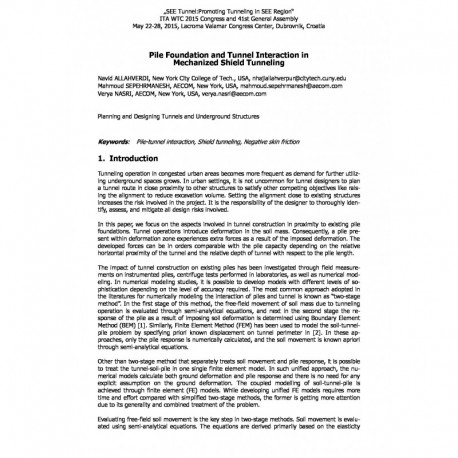Cart
0
0
No document
0,00 €
Total
Document successfully added to your shopping cart
Quantity
Total
There are 0 items in your cart.
There is 1 item in your cart.
Total documents
Total shipping
To be determined
Total
Search & filter
Search for a publication
Search & filter

Pile Foundation and Tunnel Interaction in Mechanized Shield Tunneling
wtc2015_fullpaper_allahverdi_5-1
V. Nasri / N. Allahverdi / M. Sepehrmanesh
Tunneling operation in congested urban areas becomes more frequent as demand for further utiliz-ing underground spaces grows. In urban settings, it is not uncommon for tunnel designers to plan a tunnel route in close proximity to other structures to satisfy other competing objectives like rais-ing the alignment to reduce excavation volume. Setting the alignment close to existing structures increases the risk involved in the project. It is the responsibility of the designer to thoroughly iden-tify, assess, and mitigate all design risks involved. In this paper, we focus on the aspects involved in tunnel construction in proximity to existing pile foundations. Tunnel operations introduce deformation in the soil mass. Consequently, a pile pre-sent within deformation zone experiences extra forces as a result of the imposed deformation. The developed forces can be in orders comparable with the pile capacity depending on the relative horizontal proximity of the tunnel and the relative depth of tunnel with respect to the pile length. The impact of tunnel construction on existing piles has been investigated through field measure-ments on instrumented piles, centrifuge tests performed in laboratories, as well as numerical mod-eling. In numerical modeling studies, it is possible to develop models with different levels of so-phistication depending on the level of accuracy required. The most common approach adopted in the literatures for numerically modeling the interaction of piles and tunnel is known as “two-stage method”. In the first stage of this method, the free-field movement of soil mass due to tunneling operation is evaluated through semi-analytical equations, and next in the second stage the re-sponse of the pile as a result of imposing soil deformation is determined using Boundary Element Method (BEM) [1]. Similarly, Finite Element Method (FEM) has been used to model the soil-tunnel-pile problem by specifying priori known displacement on tunnel perimeter in [2]. In these ap-proaches, only the pile response is numerically calculated, and the soil movement is known apriori through semi-analytical equations. Other than two-stage method that separately treats soil movement and pile response, it is possible to treat the tunnel-soil-pile in one single finite element model. In such unified approach, the nu-merical models calculate both ground deformation and pile response and there is no need for any explicit assumption on the ground deformation. The coupled modelling of soil-tunnel-pile is achieved through finite element (FE) models. While developing unified FE models requires more time and effort compared with simplified two-stage methods, the former is getting more attention due to its generality and combined treatment of the problem. Evaluating free-field soil movement is the key step in two-stage methods. Soil movement is evalu-ated using semi-analytical equations. The equations are derived primarily based on the elasticity


